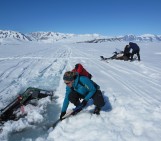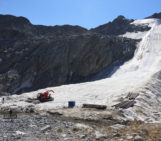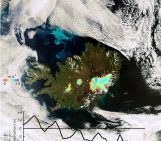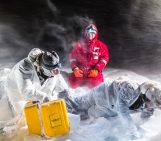
The polar regions are covered by a thin sheet of sea ice – frozen water that forms out of the same ocean water it floats on. Often, portrayals of Earth’s sea ice cover show it as a great, white, sheet. Looking more closely, however reveals the sea ice cover to be a varied and jumbled collection of floating pieces of ice, known as floes. The distribution and size of these floes is vitally important for understanding how the sea ice will interact with its environment in the future.
How big is an ice floe?
Our image of the week this week is, in fact, two images! Both images are of sea ice floes, but the images cover very different length scales. From these two images we can see the extreme variety in sea ice floe size! The left hand image, taken by a drone in the Southern Ocean, shows the Nathaniel Palmer surrounded by pieces of ice from a few meters to a few hundreds of meters in diameter. The right hand image is of the Bering Strait (85 km in width at it’s narrowest point) in May 2000, taken by the MODIS satellite. In this image, the ice floes range from kilometres to tens of kilometres in diameter. In all, the size of individual floes spans a vast range of scales, from the scale of centimetres to a hundred kilometers, a whopping 7 orders of magnitude!
Why are floes important?
As the sea ice thins, floes are becoming more important in determining how sea ice evolves because of their interaction with ocean surface waves. Large, thin floes are easily fractured by waves into smaller floes, and these small floes melt much more rapidly than large ones (Steele, 1992; Horvat et al., 2016). For example, in 2009 a group of scientists on a science cruise in the Arctic were forced to divert from their study region due to a storm. The storm generated waves that broke a wide region of coherent sea ice into a collection of small floes. When the storm was over and the scientists had returned to the study area, they observed a sea that was almost completely free of ice (Asplin et al., 2012). This sea ice melt had occurred much more rapidly than in regions that did not experience the storm, illustrating how the ocean swell, interacting with sea ice can be a mechanism to aid ice melt.
Polar storms are predicted to increase in strength in the future (Kohout et al., 2016). Therefore, understanding the interaction between sea ice floes, ocean waves, and ice melting is something that is critical for predicting the future evolution of Earth’s ice cover.
Edited by Emma Smith





Pingback: Cryospheric Sciences | Image of the Week – The shape of (frozen sea) water
Pingback: Cryospheric Sciences | More pancakes in the future!